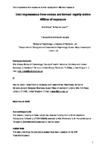Trait impressions from voices are formed rapidly within 400ms of exposure
| dc.contributor.author | Mileva, Mila | |
| dc.contributor.author | Lavan, N | |
| dc.date.accessioned | 2022-10-17T15:49:28Z | |
| dc.date.issued | 2023-02-06 | |
| dc.identifier.issn | 1939-2222 | |
| dc.identifier.issn | 1939-2222 | |
| dc.identifier.uri | http://hdl.handle.net/10026.1/19702 | |
| dc.description.abstract |
When seeing a face or hearing a voice, perceivers readily form first impressions of a person's characteristics-are they trustworthy, do they seem aggressive? One of the key claims about trait impressions from faces and voices alike is that these impressions are formed rapidly. For faces, studies have systematically mapped this rapid time course of trait impressions, finding that they are well formed and stable after approximately 100 ms of exposure. For voices, however, no systematic investigation of the time course of trait perception exists. In the current study, listeners provided trait judgments (attractiveness, dominance, trustworthiness) based on recordings of 100 voices that lasted either 50, 100, 200, 400, or 800 ms. Based on measures of intra- and interrater agreement as well as correlations of mean ratings for different exposure conditions, we find that trait perception from voices is indeed rapid. Unlike faces, however, trait impressions from voices require longer exposure to develop and stabilize although they are still formed by 400 ms. Furthermore, differences in the time course of trait perception from voices emerge across traits and voice gender: The formation of impressions of attractiveness and dominance required less exposure when based on male voices, whereas impressions of trustworthiness evolved over a more gradual time course for male and female voices alike. These findings not only provide the first estimate of the time course of the formation of voice trait impressions, but they also have implications for voice perception models where voices are regarded as "auditory faces." (PsycInfo Database Record (c) 2023 APA, all rights reserved). | |
| dc.format.extent | 1539-1550 | |
| dc.format.medium | Print-Electronic | |
| dc.language | en | |
| dc.language.iso | en | |
| dc.publisher | American Psychological Association | |
| dc.subject | first impressions | |
| dc.subject | time course | |
| dc.subject | voice | |
| dc.subject | trustworthiness | |
| dc.subject | dominance | |
| dc.subject | attractiveness | |
| dc.subject | gating task | |
| dc.title | Trait impressions from voices are formed rapidly within 400ms of exposure | |
| dc.type | journal-article | |
| dc.type | Journal Article | |
| plymouth.author-url | https://www.webofscience.com/api/gateway?GWVersion=2&SrcApp=PARTNER_APP&SrcAuth=LinksAMR&KeyUT=WOS:000925890400001&DestLinkType=FullRecord&DestApp=ALL_WOS&UsrCustomerID=11bb513d99f797142bcfeffcc58ea008 | |
| plymouth.issue | 6 | |
| plymouth.volume | 152 | |
| plymouth.publication-status | Published online | |
| plymouth.journal | Journal of Experimental Psychology: General | |
| dc.identifier.doi | 10.1037/xge0001325 | |
| plymouth.organisational-group | /Plymouth | |
| plymouth.organisational-group | /Plymouth/Faculty of Health | |
| plymouth.organisational-group | /Plymouth/Faculty of Health/School of Psychology | |
| plymouth.organisational-group | /Plymouth/REF 2021 Researchers by UoA | |
| plymouth.organisational-group | /Plymouth/REF 2021 Researchers by UoA/UoA04 Psychology, Psychiatry and Neuroscience | |
| plymouth.organisational-group | /Plymouth/REF 2021 Researchers by UoA/UoA04 Psychology, Psychiatry and Neuroscience/UoA04 Psychology, Psychiatry and Neuroscience MANUAL | |
| plymouth.organisational-group | /Plymouth/Users by role | |
| plymouth.organisational-group | /Plymouth/Users by role/Academics | |
| dc.publisher.place | United States | |
| dcterms.dateAccepted | 2022-10-11 | |
| dc.rights.embargodate | 2023-2-14 | |
| dc.identifier.eissn | 1939-2222 | |
| dc.rights.embargoperiod | Not known | |
| rioxxterms.funder | British Academy | |
| rioxxterms.identifier.project | Multimodal person perception | |
| rioxxterms.versionofrecord | 10.1037/xge0001325 | |
| rioxxterms.licenseref.uri | http://www.rioxx.net/licenses/all-rights-reserved | |
| rioxxterms.type | Journal Article/Review | |
| plymouth.funder | Multimodal person perception::British Academy |


